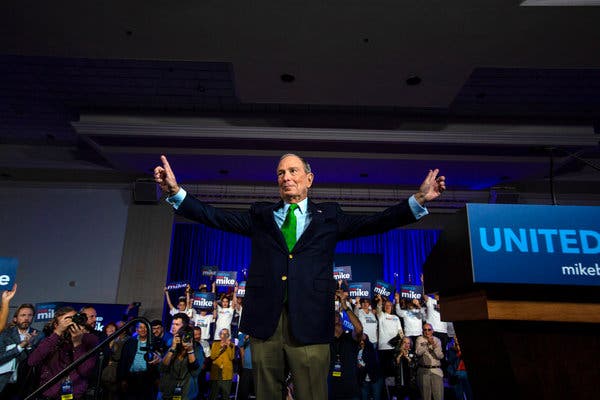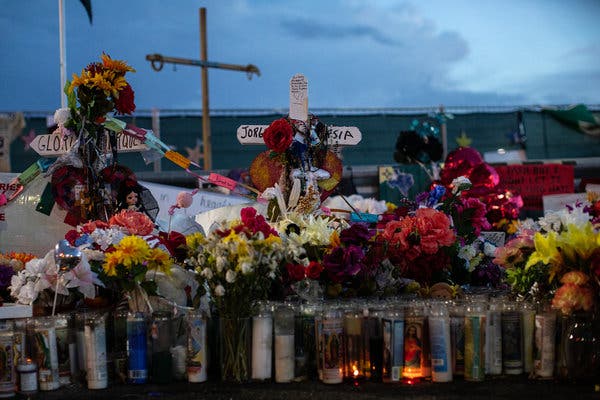Advertisement
A federal filing showing spending through December provides the most detailed description yet of how Mr. Bloomberg deployed his wealth in a quest for the presidency. The bulk went to advertising.

DES MOINES — Michael R. Bloomberg put more than $200 million of his personal fortune into his presidential campaign by the end of December, with the overwhelming bulk of that sum going to a mammoth advertising campaign on television and online, according to Mr. Bloomberg’s first campaign finance disclosure with the Federal Election Commission.
But Mr. Bloomberg’s wealth financed a huge array of campaign expenditures, many of them unusual or unheard-of for candidates of normal means, including millions of dollars in polling before Mr. Bloomberg even entered the race; $1.5 million for office space; about $700,000 for rental apartments for campaign staff; and nearly as much on travel by private jet.
The figure comes as little surprise to those who have tracked Mr. Bloomberg’s television advertising, and the total price tag for his candidacy has soared far higher in the month since the end of the reporting period. But the filing on Friday is the most detailed description yet of how Mr. Bloomberg has deployed his personal fortune in a quest for the presidency that only started in late November.
Since then, Mr. Bloomberg has climbed into the high single digits in national polls, largely on the strength of an onslaught of campaign commercials with no precedent in Democratic politics.
In addition to Mr. Bloomberg, other presidential candidates also filed their fund-raising reports on Friday, which covered the fourth quarter of 2019 and gave a snapshot of their financial resources entering 2020.
Among the leading candidates in the Democratic primary, Senator Bernie Sanders of Vermont had the largest war chest at the start of January, $18.2 million, even after spending $50 million in the fourth quarter. Pete Buttigieg, the former mayor of South Bend, Ind., entered the month with $14.5 million, while Senator Elizabeth Warren of Massachusetts had $13.7 million and former Vice President Joseph R. Biden Jr. had $8.9 million.
Federal records show Mr. Bloomberg, the former mayor of New York City, spent $132 million on television advertising, far overshadowing the campaign spending of the other Democrats in the race. In total, the Bloomberg campaign had spent $188 million by the end of December.
In addition to that sum, the campaign disclosed it had nearly $33 million in additional invoices to be paid in the next filing period, meaning that it had committed resources worth more than $220 million within his first five weeks as a candidate.
Mr. Bloomberg’s spending has largely defined his candidacy: His advertising has introduced him quickly to voters across the country who may have known little about him, and his vast fortune has made him an attractive candidate to some Democrats intrigued by the idea of attacking President Trump with an unlimited budget.
Mr. Bloomberg’s campaign manager, Kevin Sheekey, called the extraordinary use of Mr. Bloomberg’s personal wealth a “down payment’ in a statement.
“Our first month’s filing represents a down payment and commitment in all 50 states to defeat Donald Trump, and it shows we have the resources and plan necessary to take him on,” Mr. Sheekey said.
But in a party defined in no small part by concerns about inequality and economic power concentrated in the hands of the wealthy, Mr. Bloomberg’s fortune — estimated at well above $50 billion — is also a source of discomfort to many Democrats, and his lavishly funded candidacy has drawn sharp criticism from populist liberals, like Mr. Sanders and Ms. Warren.
Mr. Bloomberg’s finances are largely opaque, and they are almost certainly the most complex of all the Democratic presidential candidates. He has not released any tax returns since entering the Democratic primary, and his campaign has postponed filing a personal financial disclosure form until late March, after many of the states he is contesting will already have voted.
The way that Mr. Bloomberg has structured some of his payments offers limited visibility into his spending, including $15 million paid to his company, Bloomberg L.P., that mostly covered the period before he declared his candidacy, and another $12 million to Hawkfish, a technology firm he formed last year.
Still, the report offered a partial window into just how many consulting firms and strategists Mr. Bloomberg is employing and how much some his longtime advisers are paid.
One of the biggest payments went to Doug Schoen, a longtime pollster for Mr. Bloomberg and a Democratic strategist who has appeared often on Fox News. He was paid $3.2 million for polling and is owed nearly $4 million more — for a total of almost $7.2 million in less than two months.
Bill Knapp, a media strategist for Mr. Bloomberg, formed a new consulting firm, MRB4USA LLC, to work on the 2020 bid, according to campaign officials. That company billed the Bloomberg campaign for more than $2.8 million in November and December. Another media strategy firm, Siegel Strategies LLC, named for the ad-maker Jimmy Siegel, was paid nearly $1.5 million.
Beyond Mr. Schoen, Mr. Bloomberg has assembled a team of pollsters who have also been paid handsomely. Mr. Bloomberg has paid $700,000 to Global Strategy Group and $133,000 to Brilliant Corners, the firm run by Cornell Belcher, a former pollster for Mr. Obama. The campaign also paid $692,000 to Marathon Strategies, a consultancy founded by a Democratic strategist, Phil Singer.
One of Mr. Bloomberg’s paid consultants was also identified as a top endorser and as his “national political chair:” Michael Nutter, the former mayor of Philadelphia. Mr. Nutter’s company has billed the Bloomberg campaign for $15,000 of services.
Mr. Bloomberg’s report also indicated the fluid relationship between the people and resources deployed for his campaign and those nominally attached to his private company. The report included $12 million in payments to Mr. Bloomberg’s company, Bloomberg LP, that were listed as prepayments for campaign expenses. A campaign aide said those funds, and several other expenditures linked to Bloomberg LP, were intended to cover expenses the company would incur as a result of the campaign, including compensation for corporate employees who have shifted over to his political operation.
But it was unclear how many people that money was used to pay, and the F.E.C. report offered no way to verify exactly how the money was used.
In addition on Friday, a super PAC supporting Mr. Biden announced that it had raised $7.6 million “to date,” and revealed some of its donors — those who had given a combined $3.7 million in 2019 — for the first time.
The largest contributor, George Marcus, a California real estate investor, gave $1 million.
A dozen other donors gave at least $100,000, including: the investor Bernard L. Schwarz; Alan Leventhal, founder of Beacon Capital Partners; Joe Kiani, founder of Masimo; and Barry Gorin, the C.E.O. of a leading commercial real estate company. Executives with The Blackstone Group combined to add another $200,000.
Mr. Biden has pledged not to accept contributions from the fossil fuel industry but his super PAC, which cannot legally coordinate with the campaign, is not bound by that edict. The super PAC received $50,000 from Richard Slifka, who was listed as an executive with the Global Petroleum Corp.
Thomas Kaplan contributed reporting.
-
-
- Bernie Sanders has gained substantial ground recently, overtaking Joe Biden in Iowa and nipping at his national lead. Here’s our polling tracker.
-
- Learn more about the top-polling Democratic presidential contenders.
-




